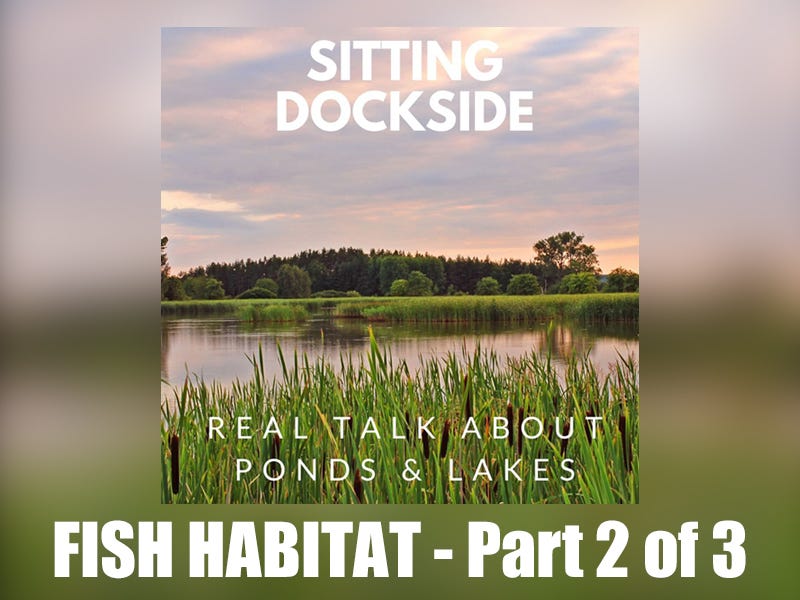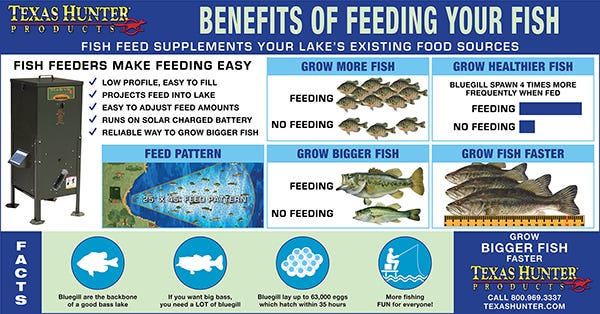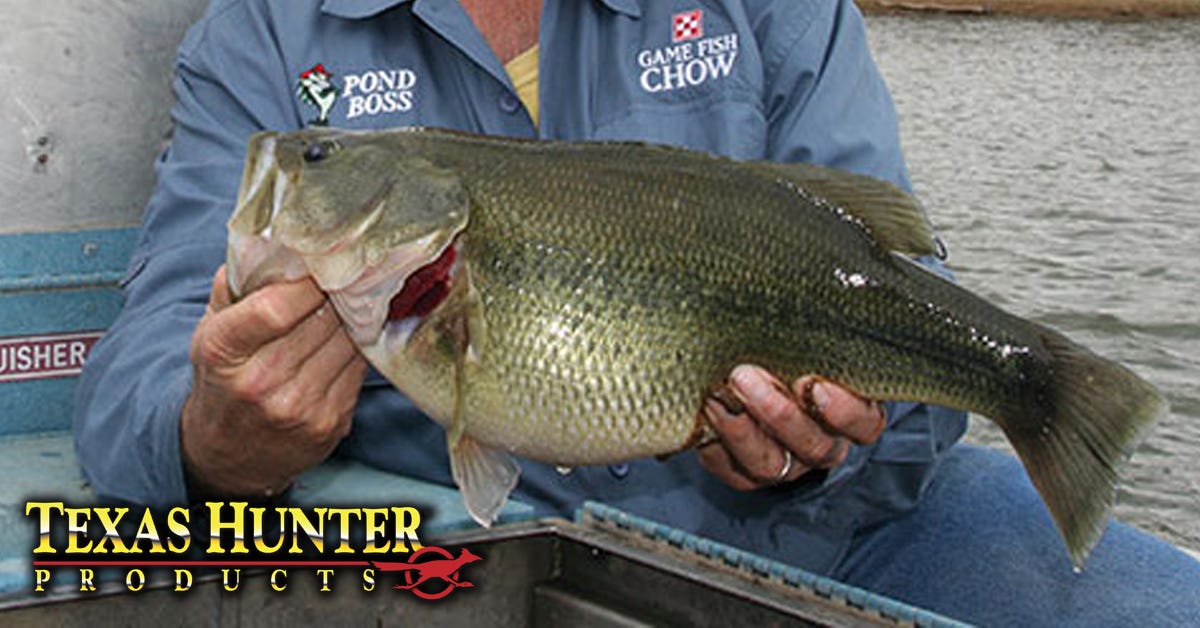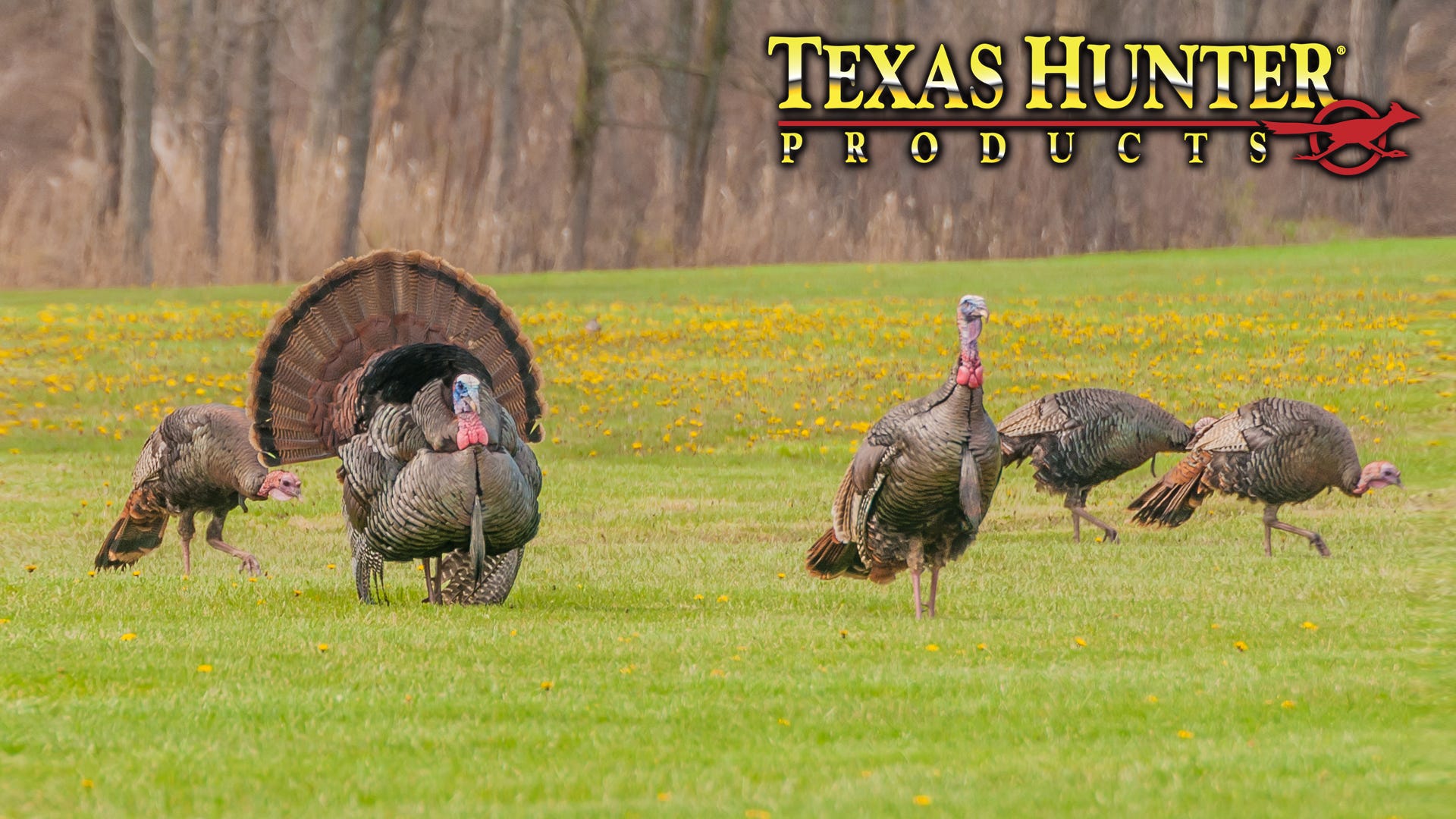- Jun 28, 2022
Sitting Dockside Podcast 66: Fish Habitat Part 2 of 3

Sitting Dockside Podcast - Episode 066- Fish Habitat
Brought to you by Private Water Natural Resources Association.
Listen to the Full Podcast. Read Part 1 here.
Troy Goldsby: Well, I think the other thing, Brian, can illuminate is proper habitat. I mean, one of the things we get into all the time is that we get into these large reservoirs where people are like, “Oh, we’re fishing grass, and everything’s great.” But, at what point does that grass become an issue? It may be good habitat for a while, but are there scenarios, Brian, where you look at a proper type of vegetation to plant versus another? Are there vegetations do you like over others?
Matt Rayl: Wait, is even further step back as vegetation, do you consider that habitat?
Dr. Brian Graeb: Can I jump in and just take a what is habitat?
Matt Rayl: Yeah, absolutely. Yeah.
Dr. Brian Graeb: This is the science. And the science and the application are two different things, so the science of habitat. Habitat is the best that, I think the best one I’ve seen is from, it’s either NMFS or NOAA, one of the one of the marine services. It’s all the things that a fish needs biotic and abiotic at multiple life stages to sustain a population.
So, it’s abiotic, its chemistry, its oxygen, its water quality, its biotic, and its structure and its other components, and it sustains. That’s the definition for them, and multiple life stages.
So what larval fish needs, what a fish egg needs is different from what an adult needs, or spawning fish. They’re all different. So, that, it’s a big, all encompassing umbrella type term that people use all the time and fisheries and science, and it’s mushy. But I used to get really kind of define, is this habitat… My new philosophy going forward, it’s all habitat.
If I put a piece, if I put a Christmas tree off my dock down here on the lake, it’s absolutely habitat. It’s serving some function. Now, is it going to make a difference in my lake? No. If I’m still extremely habitat limited, I’m going to keep adding more, adding more, until I get to where I need to be. But yeah, it’s all habitat.
Vegetation is habitat. Contours in a lake is habitat. Trees, rocks, oxygen, thermoclines, it’s all underneath this habitat umbrella. We, most people are most familiar with adding Christmas trees and structure because that’s a lot of what we do, and calling that habitat. And I think that’s absolutely habitat and can be called that.
And I think there’s a long raging debate and fisheries on attraction versus production. I think this, probably stifled fisheries research for 30 years. In the ’70s, the early reservoir gurus got to the point of saying, you know, they studied habitat, there’s some great work out of the ’70s on habitat science, where I got a lot of my stuff from. And they got to the point and said, “Well, we put in habitat, but you know, we get inconsistent results of that.”
And they weren’t measuring how much at the time, they’re just putting it in or not, bringing in and looking at types. And sometimes they get an effect, and sometimes they wouldn’t. And they would say, well, you got to be really careful. And if you just put a little bit in, you know, you track what’s in the lake to that piece of habitat, but you really haven’t improved the population. And sometimes you put a lot in in the population gets better.
So they said, in the ’70s, you got to separate attraction from production. And in all my early career, when I, I learned the same. I was blinded, I learned that, I didn’t think much about it until I had to enter that world myself and was pushed by some brilliant folks in the private sector to kind of just think about this whole question differently.
And then, it’s all habitat. Fish attracts to most, there’s so much good stuff out there, doesn’t matter. The question becomes, how much habitat do– how much do I need to put into a lake to actually start to change the population?
So I was told that reservoir aging story, right? That’s probably my best example. You flood a new reservoir, like we did. Imagine being in the 50s, 60s, 70s, has been a biologist when they’re, when the country is just building reservoirs like crazy, and we’re just stalking and trying to figure out how they work. They flooded forest, trees, that you get that trophic upsurge, habitat was all over the place.
And fast forward 20, 30 years, they start to decline, we start to stop, we started to do other things, and populations are just shifting. What’s happening is a habitat is slowly eroding underneath this, we’re not really paying attention. And then some of those reservoirs get to be 40, 50 years old, like 60 years old, like they are now.
We’re looking at what we call a habitat desert, the trees are long gone, you know, it’s just a shallow flat bottom, it’s been sedimented in. It’s the state of reservoirs now. So you start there, and you say, OK, what’s, what can I do to improve habitat? I always say, just turn the clock back. You know, you start adding habitat, making it more and more, and more like it was at its younger reservoir.
And at some point, you’re going to get back to where you were. You probably never recreate the first initial flooding event, but, at some point along there, it just makes sense scientifically that we can put enough in that we can recreate the type of dynamics we had when that reservoir was young and had lots of trees in it.
So we took those ideas, and we being, Jeff Boxrucker, some really smart scientist and fisheries and thinking about this at different angles and had some really great conferences back in, oh, 2012, ’13, ’14, those are just exploring this question, and kind of came about and just got rid of the attraction versus production debate, because it stifles us. And we said, OK, how much habitat do we need to put in to improve a fishery or to make that infrastructure, the level we need to grow a fishery on top of it?
So, that’s some of the… I will probably got way too deep in there, but that’s the history of habitat science and kind of where we’re at today. And I think it’s, yeah, that’s what, that’s kind of what’s driving us today.
So what is habitat? It’s all encompassing. Is a Christmas tree a habitat? Absolutely has some function. Fish don’t care. And vegetation without question, I shoot for similar amounts of vegetation, Troy as I do cover and structure, I want 20% to 30% of my lakes. I guess I’m probably a little biased. Growing up in the northern waters, works constantly so much trying to get vegetation to grow that we’re not picky what it is.
But now, as I spend more time in Kansas, I’m particularly had a couple of hydrilla lakes in Texas now, and there, I just do not have that one, unless I… there’s nothing else around. But yeah, the stuff I like… Yeah.
Troy Goldsby: So this, I think this is where geography comes into play for what we’re discussing. Obviously, habitat is important, and the 20% number has been tossed around for a long time now. And I agree completely, I’m not disputing the science on habitat and coverage and vegetation, and whatever you want to put in there.
The problem is, is when you get down to Texas, or Louisiana, or Alabama, or Mississippi, or Tennessee or whatever reservoirs have a lot of hydrilla, and to be honest with you, now, we’re getting a lot of Vallisneria, which is what we thought, you know, eelgrass, we thought that was the end all be all for a long time. And it’s created such a significant issue in the southeast, especially the Tennessee River system for the past two or three years. We just get these dynamics in southern waters that you may not get in the north.
And if you can maintain something, I think 20%, whether it’s vegetation, or you know, whatever it is, I think that’s awesome. We just say that these reservoirs in the southeast go from 20% to 40%, in the matter of two or three seasons. So you, then you wind up with an issue you’re trying to control and get it back to where it needs to be.
And so what you’re doing with the fish cities, I think is great. We have clients that are like, “Oh, well, I want to do vegetation.” I think that’s fine, unless you have a reservoir that cannot sustain that vegetation, if it’s going to allow that vegetation to get out of hand. And that’s where all of these fish city structures, rocks, trees, artificial habitats that are being made, whatever it is, I think that’s where those are uber important to make it a lake what it needs to be outside of utilizing vegetation.
And so I’m a little bit biased, probably on the downside of vegetation, where you all may be not. Because it doesn’t matter what I put in a reservoir down here, unless that reservoir has been designed specifically to hold vegetation. Any vegetation I put down here is likely to be an issue greater than 20% of the reservoir by far.
So that’s where once you once you get south of, you know, that Indiana line, Matt, where you all are up there being all weird. Once you get down here to Tennessee, Alabama, Mississippi, Georgia, I’ve had southern night and thinly pondweed grown 15 feet of water before, so, and thriving topped out. And so it becomes a nuisance, and that’s where vegetation gets to be this iffy structure, the iffy habitat that you may not want to have in your reservoir.
Matt Rayl: Yeah, we’ve had done plenty of talks on this philosophy of plant versus habitat. And I think you hit well, Brian, on the difference between structure and what you call habitat. But this is back to Troy’s initial question, you got to have the right habitat. And you have designed, which you talk on podcast one, and now you talk about now. You’ve designed kind of a fish city, which is you said it’s kind of a coined verbiage that you tried to have these in every single fish city. Can you define that to us a little bit better?
Dr. Brian Graeb: Yeah. A fish city, and we just use it because it’s simple, it encapsulates what we’re talking about. So for us, it’s usually a combination of, we use MossBack habitat a lot. We use a lot of that stuff and love working with those guys, and they’re– and what they’re doing, and their habitat works– their structure works great.
So, we take those and/or cedar trees usually, rocks, whatever we have available. But most commonly as some sort of artificial habitat, combined with the cedar tree if we have it, combined with rocks. We can get it gravel, sand, whatever in this com– same complex. But essentially, no matter what you have available, and make your own if you want to, we try to, we close to, we start at the shoreline, and we go out.
We started about 12, 18 inches of water. We’ll start putting structure there and we started with high density structure. And the thought there as well, a small juvenile fish, say, a bass that just popped off the nest, it’s out on its own now. It’s going to go into the shoreline, find some vegetation or find some other type structure and just going to hang out, and feed on zooplankton.
So we wanted that. We recreate that with either high density MossBacks or cedar trees right up next to the shore in amongst the vegetation. I think the two are, they’re not mutually exclusive. They’re very complementary. So anyhow, and just thinking, and so I’ll just follow the life history of fish. So a juvenile bass off the nest, up feeding shallow, they’re just eating zooplankton still. So they just need lots of cover and to zip out really quick as the zooplankton come back and just stay away from predators.
B ut as they grow, they’re going to start to transition to invertebrates, chironomids, you know, the midges, mayflies, whatever is available, and start making offshore foray, so in the middle of this whole city complex. Now, we go offshore another, probably 20 feet. We have a big, giant, we call it safe havens for MossBack, or we’ll take two or three cedar trees and just tie them all together and sink, and then make another big refuge for them in the middle of the city.
And the idea is they go from shoreline, and we create a travel corridor, they get up to the middle, they can hang out there and start feeding. And same with bluegills around, and they can be out there and start to transition bigger and bigger food, and hopefully, prey fish, and start to go and go. And all around the outside of this, we have lower density structure, and that’s where the predators hang out.
So juvenile bass, if the big ones aren’t around, the juveniles will be out there, hopefully, feeding on fish. They get the fastest growth rates. Big bass come in, they, you know, we’ve seen… this is hard to describe and I want to say too firmly, but we have a lot of science, a lot of suggestions that to kind of paint a picture on how bass forage sometimes.
We’d see telemetry fish that would run up to these fish and they’d be, they’d zip in, they kind of swim around for a little bit, sit for a minute, then they swim over to the next one, and talking to other fish folks. And that behavior is that, you know, they swim into a piece of cover, they try to flush all the prey out and find a wounded one, and zero in on that.
So in my head, I’m probably anthropomorphizing too much, but they’re just kind of seeking out and coming in. So a predator comes in the outside, they might swoop into the safe haven, and all those bass and bluegill are feeling good, flush a couple out, get a meal and go on. And they might go out to the outside of the fish city and sit on the low density structure, and this just keeps building.
And the final piece of it was something that gentleman pointed out, and this is some of those old ’70s study, the importance of shade and getting out of the sun. So on that deep water edge, and this might be out. Hopefully, if we can get enough depth, we’ll start near the shoreline. Our last piece of structure might be 75 feet offshore if you’ve got a really shallow slope. And hopefully, we can get out to 8 or 9, 10 feet of water and we’ll put tall vertical structures.
For the MossBack, we use the XL trees that stand up. And we put floats and all these, most of them, so we know that they stay upright. And that, so then we just picture predators sitting out there and they, when it’s… you know, they can sit out there and go chase shad down when they come by. They can come back in a feed on bluegill.
And threadfin or gizzard shad love these things, by the way. They get covered and purify and there’ll be in there eating them. So we routinely get shad out of them, crappie. So, a lot of different things use them. I’m using the bass example. But anyhow, the city just, it kind of incorporates. I should just call it a house, Matt, because your analogy works better. You got rooms and space for the newborns, for the juveniles, the teenagers, the college kids that just visit occasionally, and the adults. But yeah, that’s…
So a city is just, you know, a creative way to put all that together. And we standardized the design because it makes it easier to plan. And we put out… Oh gosh, I don’t know, well over probably a couple of 100 fish cities last year, just in the few lakes we were doing. But they’re all variations of the same theme. It just makes it as easy– makes it easier for us to get the materials, we know how to put them out pretty quickly now.
There’s a lot of work involved. Habitat is, you know the– it’s the most rewarding biologically because the results are, there’s so much cool science behind it. But the actual physical labor involved is challenging.
Matt Rayl: Got it. So, I think that’s why a lot managers will…
Dr. Brian Graeb: Pain in the butt.
Matt Rayl: We’ll kick it to the curb a little bit.
##
Please join us again for Part 3 coming soon. Read Part 1 here.
"Sitting Dockside" is Real Talk about Ponds & Lakes with Pond and Lake Management Experts sharing their first-hand knowledge. Its purpose is to educate pond and lake owners and lake management professionals. Matt Rayl, the host, a pond and lake professional with over 20 years of experience in the industry. If you have a pond or lake this is great place to listen and learn dockside from pond and lake management experts.
Have questions or want to share your thoughts on this subject? Join their Facebook Community.
Want help within your area with your pond or lake Aquatic vegetation and more? Check out the trusted industry sponsors at the P.W.N.R.A Sponsor Directory.
Golden Sponsor: Society of Lake Management Professionals
Please support this show and Private Water Natural Resources Association




